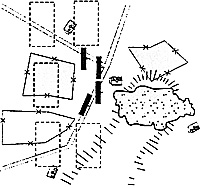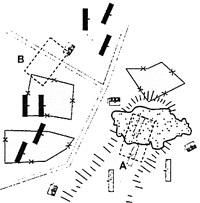"...and I believe that no troops could be expected to withstand the close and overwhelming fire that surprised our left flank and rear."
"The Fifteenth Alabama completely surprised the force in their front (the enemy's left flank)..."
"...charged the flank and rear of the enemy's pits. The enemy, surprised and panic-stricken by this impudent movement..."
"...who was particularly cautioned to be on the alert, and not allow himself to be surprised."
"...you use the utmost vigilance to prevent your command from being surprised or cut off..."
The above quotes are only a fraction of the hundreds which show, on one hand, the result of successful battle maneuvers, or, on the other hand, the dire warnings against these very movements. Over a few beers, everyone agrees that we would do it right. Unfortunately, I have found that when actually confronted by this on the table top, the first thing most of us do is moan and confront our inability to deduce that the enemy had cavalry in the woods with comments such as "you can't hide horses," or "someone would have seen them marching up," or some other such plea to stop our men and our pride from being stomped into the ground. We want to have fun; we don't want to examine every bush before advancing, or weaken our attack by detaching flank guards. After all, we only have a few hours before packing up!
Personally, I think that what transpires before the actual battle is crucial to the end result, but I agree that without preparation or an umpire, it is not possible to recreate surprise in most war- games. Just as important to the outcome is intelligent use of reserves: "use them or lose them."
I would like to share an idea I have to bring a taste of the real 'fog of war' into a normal game.
Reserve Force
The idea revolves around the use of a 'reserve' force and a map of the battlefield. Each side's order of battle would be chosen at random from an army list of the forces available, and would therefore be unknown to the other player. From this order of battle, a player would choose his reserve; this could be anything from a few regiments to one third of his total army, depending on the size of the game. Deployment of these forces on the table would be marked on the map for the eventual deployment of the reserve. This can be anywhere in your own area or beyond; however, if you choose beyond, you must first have traversed that area with friendly troops and there must be no enemy at that point when your reserve finally arrives.
Using this system, it is possible to reinforce a breakthrough or prop up a crumbling defense without spending all afternoon marching troops from the table's edge, just to get packed away as one side or the other admits defeat, or your wife/girlfriend want some of your already rare 'quality time.' Like the real thing, however, you cannot rely one hundred percent on your reserve turning up exactly when you need it. but you can influence its arrival as much as possible by having it made up of reliable (elite) troops and/or dependable (superior) officers.
I therefore offer the following guidelines:
-
1. Choose your reserve if required, and note it down.
2. Mark your deployment on your map and clearly mark the area allotted to the reserve. This need not be done immediately,; however, the reserve cannot be diced for until the move after it is marked up. (Needless to say, it is difficult, before an engagement, to know when you will need to commit your reserves.)
 3. Dice on the turn you wish to call up your reserve; the number rolled on the dice is the number of moves before it arrives. This can be modified only by the following: +1 for a poor commander, +1 if the reserve is composed of more than 50% green troops, -1 for a superior commander, and -1 if the reserve is composed of more than 50% elite troops. (The lesson here is that you don't rely on Franz Sigel to pull you out of the mire.)
3. Dice on the turn you wish to call up your reserve; the number rolled on the dice is the number of moves before it arrives. This can be modified only by the following: +1 for a poor commander, +1 if the reserve is composed of more than 50% green troops, -1 for a superior commander, and -1 if the reserve is composed of more than 50% elite troops. (The lesson here is that you don't rely on Franz Sigel to pull you out of the mire.)
4. When the reserve does arrive, it must do so either behind or on the immediate flank of a friendly line of battle; if the latter, then it must be no closer to the enemy than one foot and no charges can be declared on the first turn it arrives (see figure 1 at right).
5. If the reserve area has been overrun, then it must arrive one foot to the rear and towards an approach road (see figure 2 at left).
 6. The reserve is deemed to have formed line of battle before it is placed on the table; therefore, its deployment must be noted before its arrival. It is also assumed that the reserve
commander had been kept up to date on the situation; therefore, his line of battle can face in any direction as long as the bulk of his troops remain in the deployment area.
6. The reserve is deemed to have formed line of battle before it is placed on the table; therefore, its deployment must be noted before its arrival. It is also assumed that the reserve
commander had been kept up to date on the situation; therefore, his line of battle can face in any direction as long as the bulk of his troops remain in the deployment area.
Mixed Reception
I have used this system once to a mixed reception. Being the CinC, I had command of the reserve, and chose to advance and have it arrive, hopefully, behind my victorious troops, who would sweep the enemy from the forward deployment area. I did manage to drive back the enemy, but the attack broke up my leading brigade and the reserve then arrived on my flank, fully formed, at just the right moment to seal my victory. Unfortunately, the enemy reserve arrived on my flank in a wood which I had completely ignored, the result being that my reserve had to counter that of the enemy.
I have tried to keep things simple, but other refinements could be added. For instance, the reserve could be at the beck and call of any commander who thinks he needs it the most, thus leaving room for all sorts of mayhem and after-game recriminations, just like the real thing, really. The effect of terrain is more difficult to to calculate. You either ignore it completely for ease of play, or at the very least, your common sense. For instance, if a reserve arrives in a wide open area with no cover, then it stands to reason that the troops may have been spotted deploying by the opposite side; to offset this, I would recommend the enemy get a warning so they can see troops approaching that area one turn before arrival.
I plan to use this system again and believe it could really be useful in campaign battles. It may take some persuasion to get your fellow players to enter the realm of the unknown. But if you do, or if you can offer any refinements, write it up for the magazine.
Back to The Zouave Vol XI No. 4 Table of Contents
Back to The Zouave List of Issues
Back to Master Magazine List
© Copyright 1997 The American Civil War Society
This article appears in MagWeb (Magazine Web) on the Internet World Wide Web.
Other military history articles and gaming articles are available at http://www.magweb.com